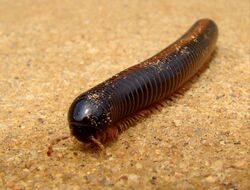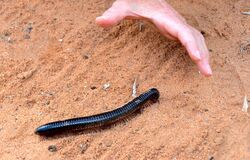Biology:Archispirostreptus gigas
| Giant African millipede | |
|---|---|

| |
| Scientific classification | |
| Domain: | Eukaryota |
| Kingdom: | Animalia |
| Phylum: | Arthropoda |
| Subphylum: | Myriapoda |
| Class: | Diplopoda |
| Order: | Spirostreptida |
| Family: | Spirostreptidae |
| Genus: | Archispirostreptus |
| Species: | A. gigas
|
| Binomial name | |
| Archispirostreptus gigas (Peters, 1855)
| |
| Synonyms[1] | |
| |
Archispirostreptus gigas, known as the giant African millipede or shongololo, is the largest extant species of millipede, growing up to 33.5 centimetres (13.2 in) in length, 67 millimetres (2.6 in) in circumference. It has approximately 256 legs, although the number of legs changes with each molting so it can vary according to each individual.[2]
It is a widespread species in lowland parts of East Africa, from Mozambique to Kenya, but rarely reaches altitudes above 1,000 metres (3,300 ft).[3] It lives mostly in forests, but can also be found in areas of coastal habitat that contain at least a few trees.[3] It is native to Southern Arabia, especially Dhofar.
In general, giant millipedes have a life expectancy of about 7–10 years.[4] Giant millipedes have two main modes of defence if they feel threatened: curling into a tight spiral exposing only the hard exoskeleton, and secretion of an irritating liquid from pores on their body. This liquid can be harmful if introduced into the eyes or mouth.[4] Because of this defense, A. gigas is one of the few invertebrates that driver ants are incapable of taking as prey. The chemicals identified in this millipede’s defensive secretion are toluquinone and 2-methoxy-3-methylbenzoquinone[5]
Small mites are often observed crawling on their exoskeleton and among their legs. The millipedes have a symbiotic relationship with these mites, in which the mites help clean the millipede's exoskeleton in exchange for food and the protection of their host.[6]
A docile species, A. gigas is sometimes seen in the pet trade.[7] However, the U.S. federal government requires anyone bringing giant millipedes into the country to have permits for them.[8]
References
- ↑ Spelda J. (2016). SysMyr: Systematic Myriapod Database (version Apr 2013). In: Species 2000 & ITIS Catalogue of Life, 29th January 2016 (Roskov Y., Abucay L., Orrell T., Nicolson D., Kunze T., Flann C., Bailly N., Kirk P., Bourgoin T., DeWalt R.E., Decock W., De Wever A., eds). Digital resource at http://www.catalogueoflife.org/col/details/species/id/b67b4036768e01b126a3097ef8174d9d. Species 2000: Naturalis, Leiden, the Netherlands. ISSN 2405-8858
- ↑ Mark Carwardine (2008). "Centipedes and millipedes". Animal Records. Sterling Publishing Company. pp. 216–217. ISBN 978-1-4027-5623-8.
- ↑ 3.0 3.1 R. L. Hoffman (2000). "Millipedes". in Neil D. Burgess. Coastal forests of Eastern Africa. IUCN. ISBN 978-2-8317-0436-4.
- ↑ 4.0 4.1 "Giant African Millipede". Oakland Zoo. http://www.oaklandzoo.org/Giant_African_Millipede.php.
- ↑ Wood, William F. (1974). "Toluquinone and 2-Methoxy-3-methylbenzoquinone from the Defensive Secretions of Three African Millipedes". , Annals of the Entomological Society of America 67: 988. doi:10.1093/aesa/67.6.988.
- ↑ "Giant African Millipede". Rosamond Gifford Zoo. 3 January 2006. http://rosamondgiffordzoo.org/assets/uploads/animals/pdf/GiantAfricanMillipede.pdf.
- ↑ "Giant African Millipede". Cosley Zoo. https://cosleyzoo.org/giant-african-millipede/. "Giant African millipedes are sometimes kept as pets."
- ↑ "CBP Intercepts Giant Millipedes at SFO Mail Facility" (Press release). San Francisco, CA: U.S. Customs and Border Protection. August 29, 2014. Retrieved 2023-07-05.
U.S. Customs and Border Protection agriculture specialists assigned to the international mail facility at San Francisco International Airport discovered 20 live giant millipedes while inspecting a package marked 'toy car model'…Although it is not illegal to import exotic animals, federal agencies such as U.S. Department of Agriculture and U.S. Fish and Wildlife Service regulate such imports and require certain permits and documentation. This package lacked required import permits and was misrepresented in an attempt to bypass federal regulations.
External links
- Giant African Millipede (Archispirostreptus gigas), Point Defiance Zoo & Aquarium
- Giant millipedes as pets , About.com
Wikidata ☰ Q1954820 entry
 |


